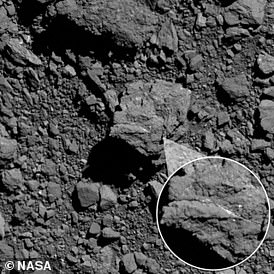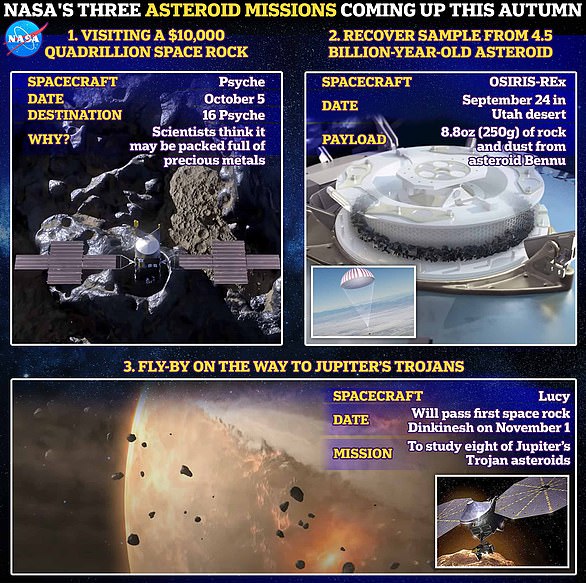How NASA’s asteroid sample will be brought back to Earth: Capsule carrying dust from a 4.5 billion-year-old space rock is hurtling towards Utah desert ahead of Sunday’s historic landing
Its cargo is so precious that it could help answer some of humanity’s biggest existential questions.
That’s why there’s so much excitement about the return of the OSIRIS-REx spacecraft, which will drop a capsule full of 4.5 billion-year-old space dust back to Earth on Sunday.
The 250-gram sample, boldly seized from the mountainous asteroid Bennu in October 2020, could shed light on how life emerged on Earth and whether we are alone in the universe.
OSIRIS-REx began its two-year, four-month journey home in May 2021, after being turned off during the journey to conserve energy.
However, in the early hours of Sunday, the probe will wake up from this low-power mode ahead of the all-important delivery.
How NASA’s asteroid sample will be brought back to Earth: This image shows step-by-step how a capsule carrying dust from a 4.5 billion-year-old space rock will make its historic landing in Utah on Sunday
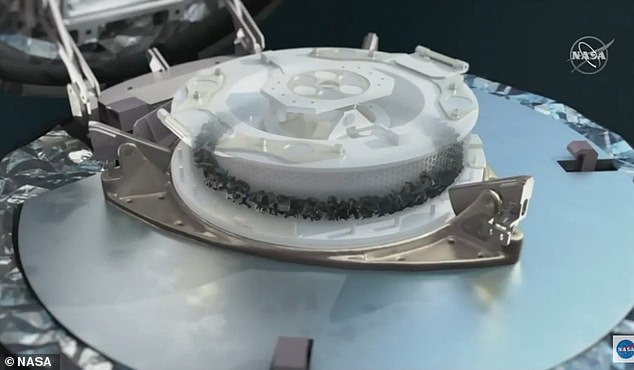
Special delivery! The 250 gram sample of rock and dust will be dropped to Earth on Sunday by the OSIRIS-REx spacecraft
NASA engineers will want to be sure that OSIRIS-REx’s trajectory and orientation are exactly right, because even the slightest misalignment could spell disaster for the mission.
That could mean the capsule either burns up in Earth’s atmosphere or misses the planet completely and blasts off into space.
Once they are satisfied with their calculations, the spacecraft will jettison its payload at 6:42 AM ET (11:42 BST), approximately 63,000 miles above Earth.
OSIRIS-REx will then begin its next mission by heading towards the asteroid Apophis, which it will reach in 2029 before an eighteen-month surveillance period.
Meanwhile, the capsule will fly into Earth’s upper atmosphere about four hours after separation at a speed of 27,000 miles per hour — more than 15 times the speed of a rifle bullet.
This will produce a fireball in the sky, but a heat shield will protect the priceless asteroid material inside as the capsule experiences forces up to 32 times Earth’s gravity.
A drogue parachute will then deploy at approximately 10:42 ET (15:42 BST) to slow the capsule slightly, from hypersonic to subsonic speeds.
Shortly thereafter, engineers should see the plane enter U.S. airspace Department of Defense Utah Test and Training Range in Utah’s Western Desert at approximately 10:46 ET (15:46 BST).
Once the capsule reaches an altitude of 1.6 kilometers, the main parachute will deploy approximately eight minutes after drogue.
This will slow the package to speeds of 18 km/h before hopefully making a soft landing on the desert floor at around 10:55 ET (15:55 BST).
At this point the capsule will be checked for structural integrity before soil samples are taken and tested to rule out the possibility of the Bennu material being contaminated by its impact on the Earth’s surface.
The sample will then be taken to a nearby mobile cleanroom for safekeeping until it can be transported to a new laboratory at NASA’s Johnson Space Center in Houston, home to hundreds of pounds of lunar material collected by the twelve Apollo moonwalkers.
OSIRIS-REx, an acronym for “Origins, Spectral Interpretation, Resource Identification, Security-Regolith Explorer,” became the first U.S. mission to collect a sample from an asteroid when it briefly landed on Bennu in 2020, scooping up material with its robotic arm.
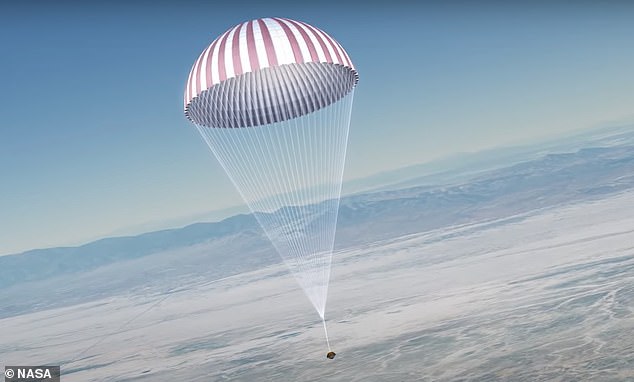
Coming home: The sample recovered by OSIRIS-REx is returned to Earth and lands at the Utah Test and Training Range
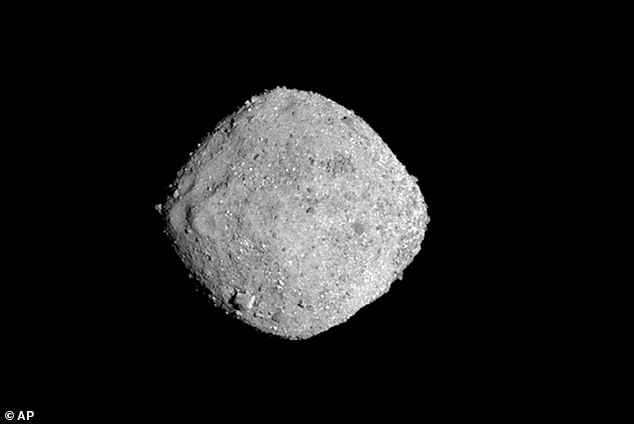
Huge: Bennu is about the size of the Empire State Building and about 200 million miles away
The space rock is about the size of the Empire State Building and is about 200 million miles away from us.
It is of great interest to scientists because it is believed to contain microscopic mineral grains that predate the solar system.
This carbon-rich material is also thought to contain the preserved building blocks of life and could help experts better understand how the planets were formed and how life emerged on Earth.
The sample recovered by OSIRIS-REx is the largest from a NASA mission since the Apollo astronauts returned with moon rocks in the 1960s and 1970s.
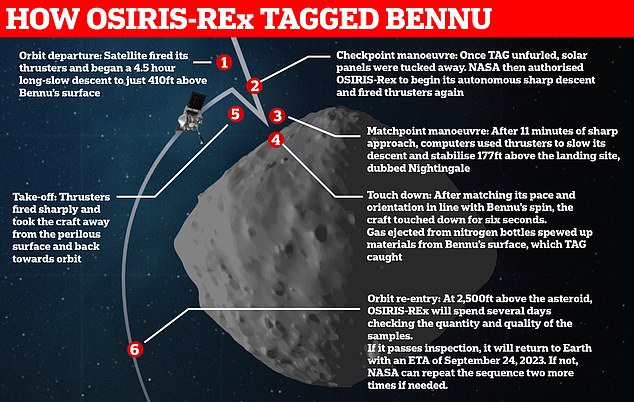
OSIRIS-REx became the first US mission to collect a sample from an asteroid when it briefly landed on Bennu in October 2020, scooping up material with its robotic arm
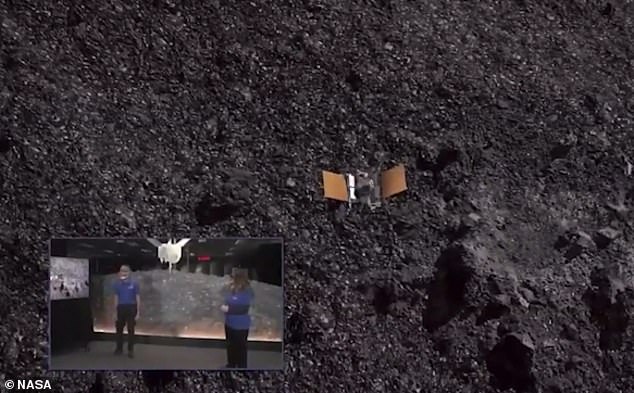
Touchdown! NASA’s OSIRIS-REx spacecraft made its historic landing on Bennu in 2020
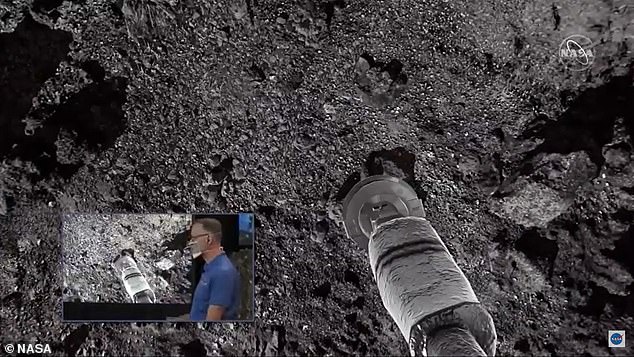
The robotic arm acted as a pogo stick, bouncing on the asteroid’s surface to collect dirt and dust before launching the spacecraft back into space. A simulation of the landing is shown above

